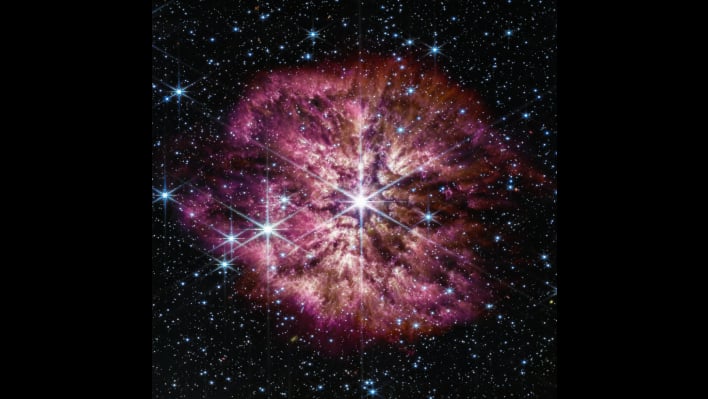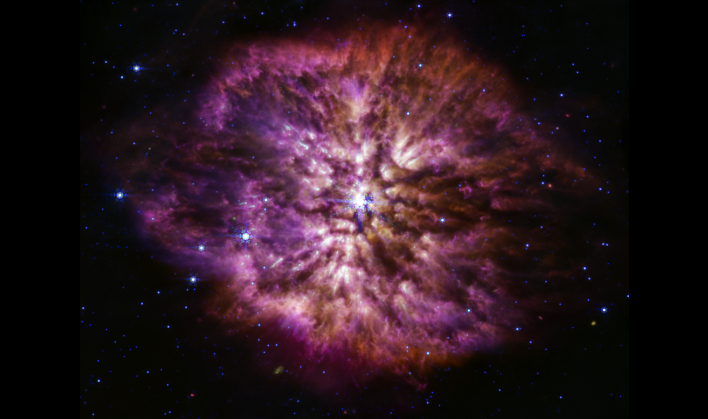NASA's Space Telescope Shares Stunning Image Of A Star In Rare Detail Before It Explodes
NASA's James Webb Space Telescope (JWST) captures a rare sighting of a Wolf-Rayet star before it goes supernova. As of right now, Wolf-Rayet 124 (WR 124) is 30 times the mass of our Sun and has shed 10 Suns' worth of material.
Wolf-Rayet stars are some of the brightest and most briefly detectable stars known, according to NASA. The image of WR 124 was actually one of the first images JWST captured after being launched into deep space in 2022. WR 124 is located approximately 15,000 light-years away from Earth in the constellation Sagittarius.
The significance of capturing an image of a Wolf-Rayet star lies in astronomers being able to further study the origins of cosmic dust. After a star goes supernova, the blast contributes to the universe's "dust budget". The dust in the aftermath is believed to be integral to the workings of the universe, as it helps shelter forming stars, comes together to aid in forming planets, and serves as a platform for molecules to form, according to a recent NASA blog post. The dilemma facing astronomers is figuring out why there is more dust in the universe than current dust-formation theories can account for.
Wolf-Rayet stars are said to have contributed to star and planet formation in the early universe. A Wolf-Rayet star clears and area as it goes supernova, and the leftover material can then pile up and become dense enough to form new stars. There is some evidence to suggest that our very own Sun formed in a similar way. Astronomers estimate there should be a few thousand Wolf-Rayet stars in our galaxy, but only about 600 have been found thus far.
JWST used its powerful infrared instruments to snag the photo of WR 124 in July of 2022. The space telescope's Near-Infrared Camera (NIRCam) is capable of balancing the brightness of the luminous star's stellar core and the "knotty" details in the less vivid surrounding gas. The image of WR 124 can be used to compare to future images of the remaining life of WR 124, and the aftermath after it goes supernova. This will provide data on whether the dust grains surrounding the star are plentiful enough to survive the blast and then become part of the overall dust budget.
Astronomers will also be able to use the data gathered from the image of WR 124 to further study a "crucial period in the early history of the universe." The detailed image of WR 124 will preserve a moment in the universe's history that can be used in future studies to help unlock more mysteries of space and cosmic dust.
Wolf-Rayet stars are some of the brightest and most briefly detectable stars known, according to NASA. The image of WR 124 was actually one of the first images JWST captured after being launched into deep space in 2022. WR 124 is located approximately 15,000 light-years away from Earth in the constellation Sagittarius.
The significance of capturing an image of a Wolf-Rayet star lies in astronomers being able to further study the origins of cosmic dust. After a star goes supernova, the blast contributes to the universe's "dust budget". The dust in the aftermath is believed to be integral to the workings of the universe, as it helps shelter forming stars, comes together to aid in forming planets, and serves as a platform for molecules to form, according to a recent NASA blog post. The dilemma facing astronomers is figuring out why there is more dust in the universe than current dust-formation theories can account for.
Wolf-Rayet stars are said to have contributed to star and planet formation in the early universe. A Wolf-Rayet star clears and area as it goes supernova, and the leftover material can then pile up and become dense enough to form new stars. There is some evidence to suggest that our very own Sun formed in a similar way. Astronomers estimate there should be a few thousand Wolf-Rayet stars in our galaxy, but only about 600 have been found thus far.
JWST used its powerful infrared instruments to snag the photo of WR 124 in July of 2022. The space telescope's Near-Infrared Camera (NIRCam) is capable of balancing the brightness of the luminous star's stellar core and the "knotty" details in the less vivid surrounding gas. The image of WR 124 can be used to compare to future images of the remaining life of WR 124, and the aftermath after it goes supernova. This will provide data on whether the dust grains surrounding the star are plentiful enough to survive the blast and then become part of the overall dust budget.
Astronomers will also be able to use the data gathered from the image of WR 124 to further study a "crucial period in the early history of the universe." The detailed image of WR 124 will preserve a moment in the universe's history that can be used in future studies to help unlock more mysteries of space and cosmic dust.



